Resembling a human arm, a tree-trunk porch-support column ushers children into the Blakely Elementary School. Its smooth, barkless surface begs to be touched by students, most of whom live among the tall firs of Bainbridge Island, an exurban redoubt of tiny farms and waterfront houses 35 minutes west of Seattle by ferry.
Children discover many such evocative, tactile elements throughout the 63,800-square-foot, $34 million school, which was designed by Seattle-based Mithun for 450 students in pre-K through the fourth grade. There are kid-size niches fitted along the entry portico that invite exploration. In the library, children can stack laminated wood blocks to clamber upon, or gather them around to form a story nook. These are grace notes with a pedagogical intent: “We wanted to have the entire school available for learning,” says Tamela Van Winkle, the executive director of Facilities Operations and Capital Projects for the Bainbridge Island School District.
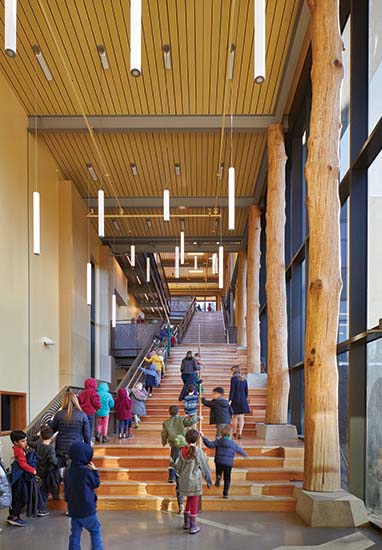
Columns fashioned from tree trunks announce the entry to Blakely Elementary (top) and continue indoors, marching up one side of a grand stair (above). Photo © Benjamin Benschneider, click to enlarge.
Beginning at the entry porch, with its stately procession of tree columns, a circulation spine organizes the school’s steel-framed branching wings: administrative offices to the south and a gymnasium, cafeteria, and music room that extend north, all clad in irregularly corrugated coffee-colored metal panels. Diagonal steel-tube braces throughout are painted bright orange. The spine ascends as a window-walled stair through the heavily planted landscape as it negotiates a steep grade change to the classroom clusters. Students naturally have appropriated the wood steps of the tree-columned space—15 feet across at its widest point—for sunlight-drenched play. On higher ground, the spine passes through a courtyard wrapped by classrooms and then culminates in the library.
An intense programming exercise was undertaken by teachers with the architects to refine a shared-learning concept: they wanted the design to encourage instructors to collaborate and provide them the flexibility to address varied learning opportunities. From these workshops, Mithun developed clusters of four classrooms configured to feed into L-shaped shared spaces on two floors. Teachers coordinate the formation of small groups that split off from the main class to pursue a project or receive extra help in the communal learning areas. Thanks to large windows, everyone is aware of the diverse activities taking place both in and beyond the classroom. “Pedagogically, education is transitioning from teacher-centric to student-centric,” explains principal Reese Ande. “We give more individual attention that is customized to students. So the building has to allow spaces to be used in multiple ways.”
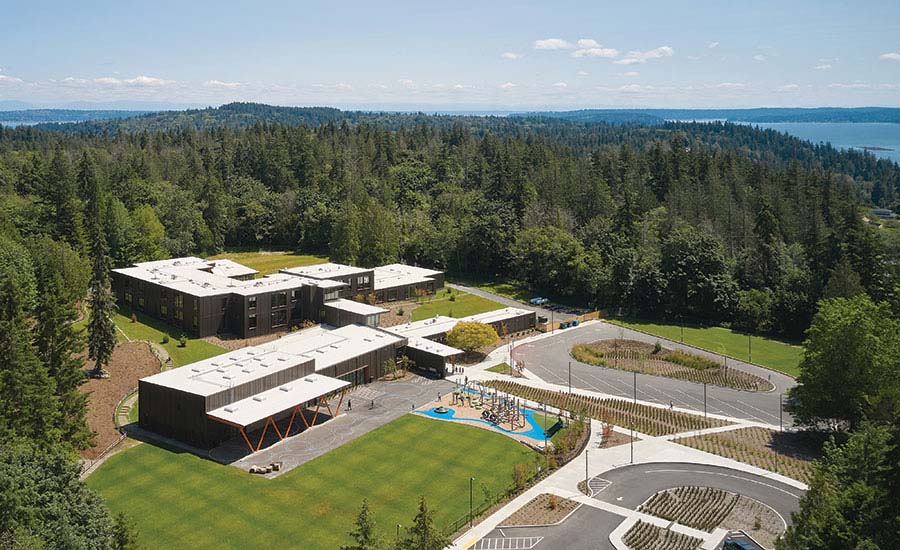
1
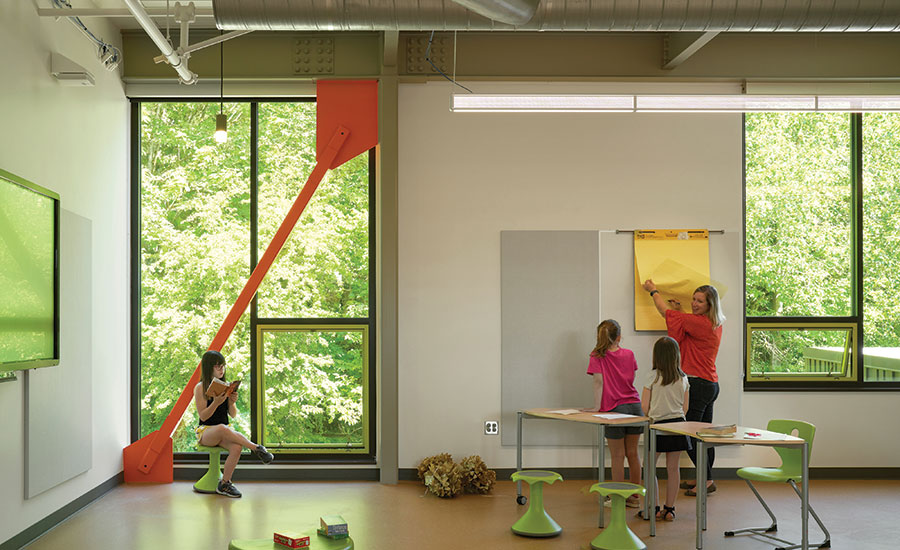
2
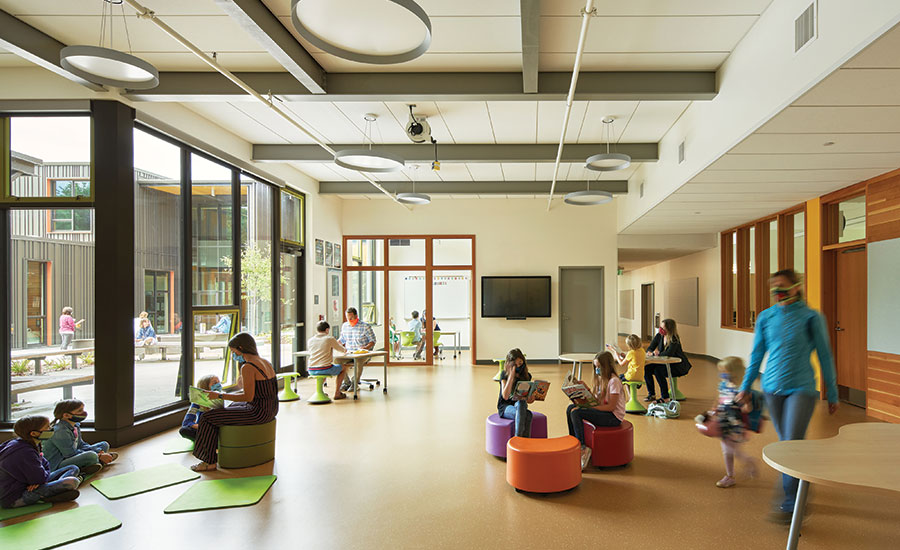
3
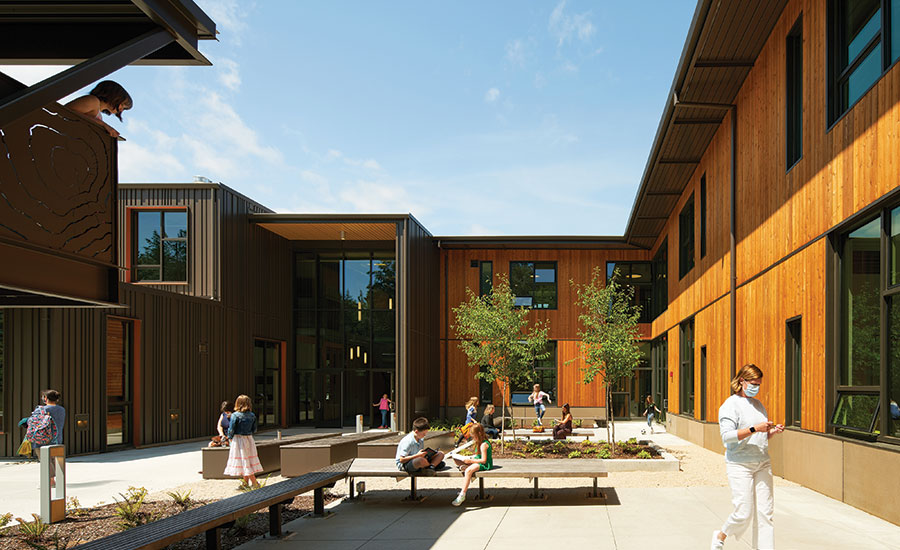
4
The school which sits on a sloping site (1), is organized around clustered classrooms (2) to define shared indoor (3) and outdoor (4) learning spaces. Photos © Kevin Scott
“The L arrangement gives all four classrooms in each cluster equal purchase on the shared learning space,” explains Richard Franko, Mithun’s design partner on the project. Some of the clusters wrap an outdoor courtyard, which brings in more daylight. With various bench layouts, the courtyards offer an additional place to address differing student needs, when weather permits.
A second theme, reflecting a strong local environmental ethos, is to keep students in touch with nature and aware of how the building advances sustainability and adapts to climate-change effects. Ample windows look out to the surrounding woodlands, with daylight from these openings balanced by skylights or light tubes in areas farthest from glazing. On most days, few electric lights are needed. The operable windows and ventilating chimneys aid air circulation.
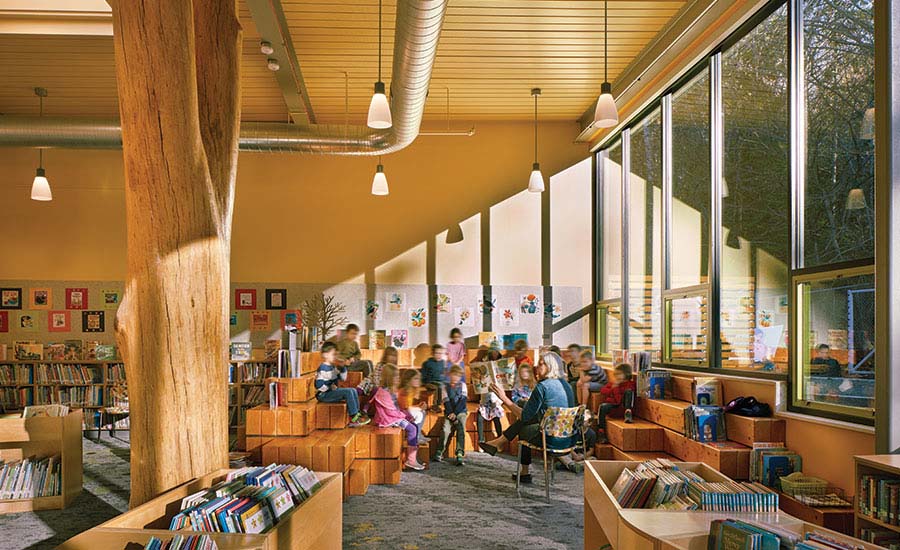
5
The library, (5 & 6) includes wood blocks that students can climb upon or rearrange to use as seating. Photos © Benjamin Benschneider (5), Kevin Scott (6)
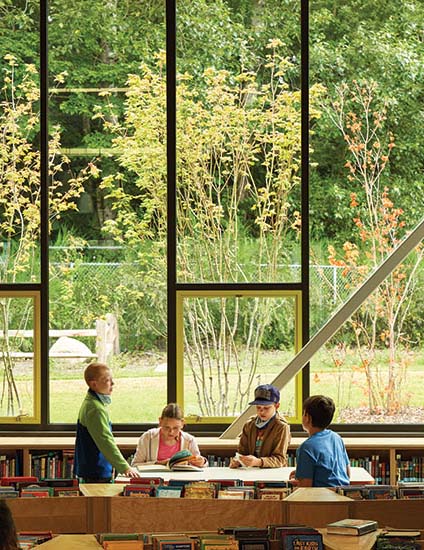
6
The school layers HVAC strategies to achieve low energy consumption at low capital costs. A 40-well ground-source heat pump system provides heating and cooling to the building and reduces energy use by about 25 percent relative to a conventional system, according to Franko. Space conditioning is conveyed hydronically to fan-powered terminal units.
A dedicated outdoor air system (DOAS) with heat recovery provides filtered fresh air directly to each classroom. This ventilation system was not designed with the highly transmittable Covid virus in mind, but the 100 percent fresh air will add a degree of safety once schools reopen. (Blakely welcomed students in September 2019 and shifted to online teaching in March 2020.)
Strict environmental requirements called for emulating pre-development runoff conditions on the 12-acre site. Stormwater flows through plantings in two bioretention basins—the largest located within the drop-off area—that scrub more than 90 percent of pollutants. The clean water flows into two concrete cisterns holding up to 402,000 gallons; then it is slowly released into the surrounding soil. Many of the 20,000 new native, drought-tolerant trees, shrubs, and grasses were planted along the northeastern edge of the property to protect a pristine wetland on a neighboring parcel.
In keeping with the project’s environmental priorities, Mithun had hoped to specify timber from the region for the tree-trunk columns. But local conifers could not be sustainably sourced, finished, and graded for structural capacity when the school was being designed. Instead the architects obtained oaks from a specialist Wisconsin company. Steel plates slotted into the logs are bolted to the building’s steel framing and concrete floor slabs.
Administrators often fear that the direct involvement of teachers adds uncertainty to the design process. But school principal Ande says, “One reason the school is so successful is the amount of buy-in and leverage the staff had.” Its participatory design process helped Blakely seamlessly unite pedagogical and environmental aspirations as a kid-pleasing and teacher-friendly package.
Click graphic to enlarge
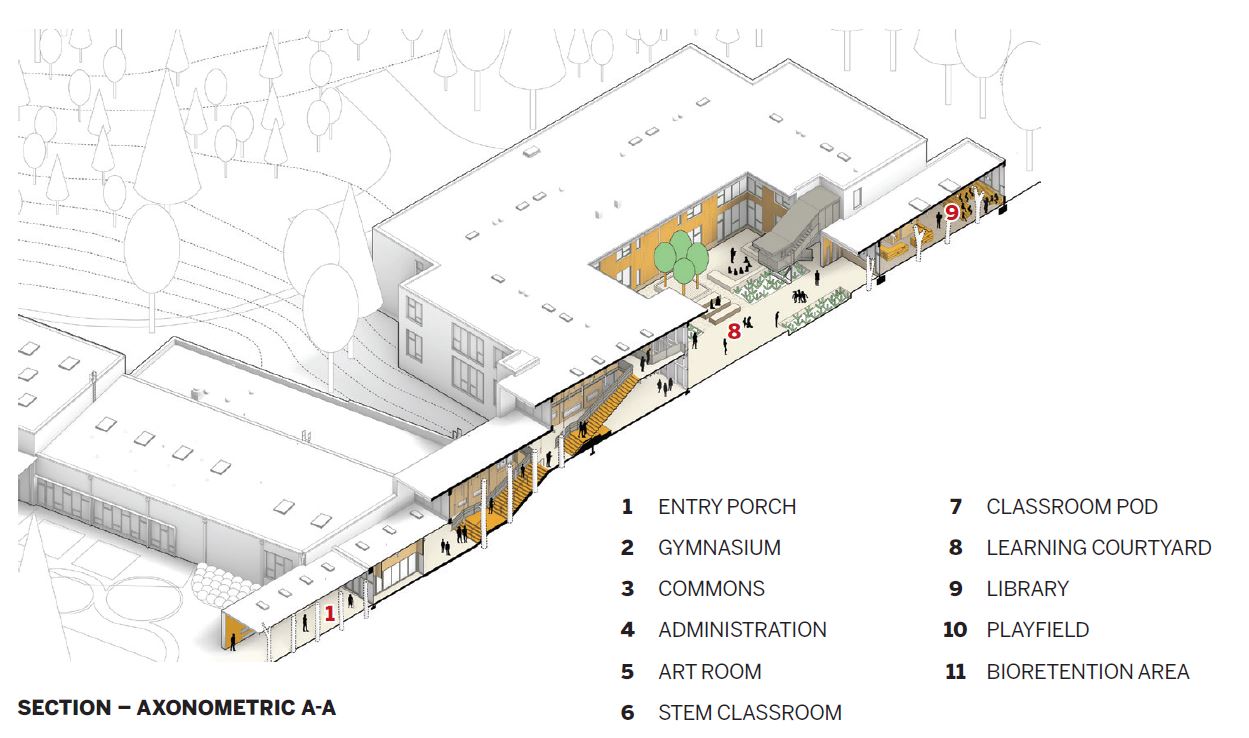
Click plan to enlarge
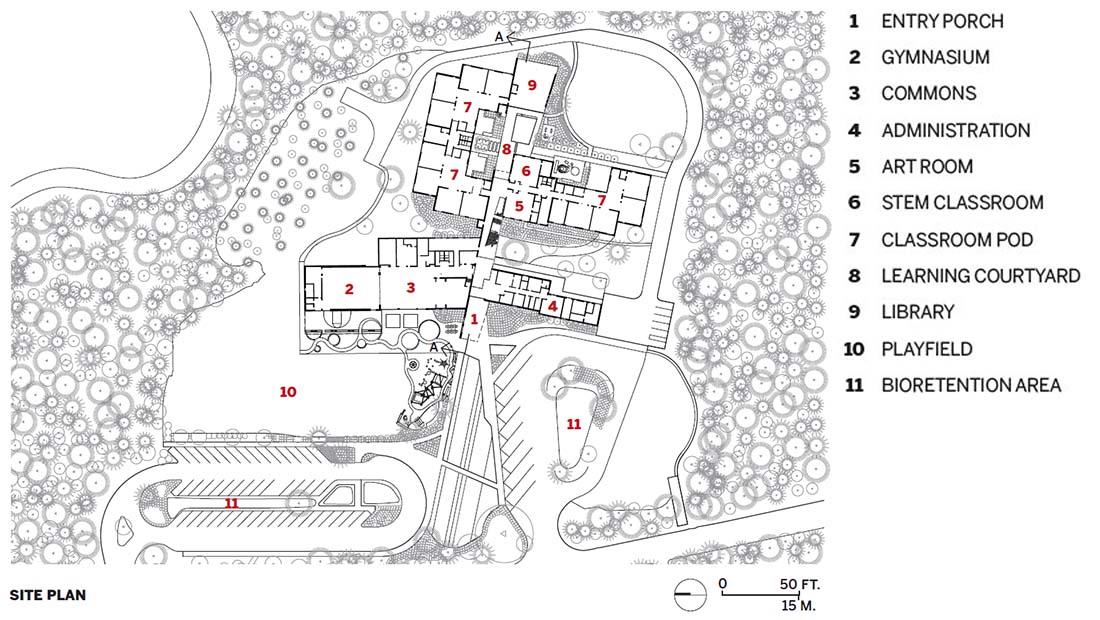
Credits
Architect:
Mithun — Richard Franko, design partner; Séamus Kelly, project architect; Michael Everett, architect; Michael Fiegenschuh, project manager; Brendan Connolly, programming; Christian Runge, landscape architect; Susan Olmsted, architect/landscape architect; Elizabeth MacPherson, interior designer; Lisa Hartanov, interior designer
Consultants:
LPD Engineering (civil); PCS Structural Solutions (structural); Arup (m/e/p, lighting, security); Mithun (landscape); JRS (envelope)
General Contractor:
Forma Construction
Client:
Bainbridge Island School District
Size:
63,800 square feet
Cost:
$34 million
Completion Date:
September 2019
Sources
Tree Columns:
WholeTrees
Metal Panels:
AEP Span
Curtain Wall:
Kawneer
Moisture Barrier:
VaproShield
Roofing:
Soprema
Glass:
Northwestern Industries
Skylights:
Velux
Acoustical Ceilings:
Armstrong
Pendant Lighting:
BuzziSpace
Plastic Laminate:
Formica
Resilient Flooring:
Nora
Raised Gym Floor:
Robbins
Carpet:
Mohawk
Elevators:
Schindler
Fire-Control Doors:
Overhead Door


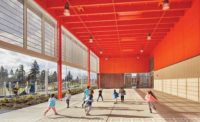
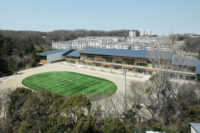
Post a comment to this article
Report Abusive Comment